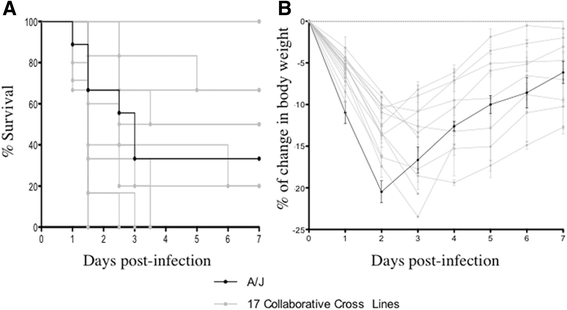Host genetic diversity influences the severity of Pseudomonas aeruginosa pneumonia in the Collaborative Cross mice
- PMID: 26310945
- PMCID: PMC4551369
- DOI: 10.1186/s12863-015-0260-6
Host genetic diversity influences the severity of Pseudomonas aeruginosa pneumonia in the Collaborative Cross mice
Abstract
Background: Pseudomonas aeruginosa is one of the top three causes of opportunistic infections in humans. Patients with a compromised immune system, due to immunosuppressive therapies or underlying diseases such as cancer, AIDS or the hereditary disease cystic fibrosis, are at risk of developing P. aeruginosa infection. However, clinical evidence indicates extremely variable outcomes of P. aeruginosa infections in individuals at risk, suggesting that host multi-complex genetic traits may influence the severity of this opportunistic infection. Here, we have used an innovative experimental model to dissect whether host genetic background, such as those found in the outbred population, could influence the risk of morbidity and mortality to P. aeruginosa pneumonia.
Results: A highly genetically-diverse mouse resource population, Collaborative Cross (CC) mice, was infected with a clinical strain of P. aeruginosa and subsequently monitored for mortality, mean survival time, and morbidity, change in body weight for seven days post infection. Disease phenotypes ranged from complete resistance and recovery of body weight to lethal disease. Initial variables, including body weight, age and gender, have limited influence on P. aeruginosa outcome, emphasizing the role of host genetic background in defining the risk of morbidity and mortality. When broad-sense heritability of phenotypic traits was evaluated, it confirmed the influence of genetic profile rather than environmental factors among the CC lines during P. aeruginosa infection.
Conclusion: This innovative model system can potentially reproduce the variables responses of disease severity observed in humans during P. aeruginosa pneumonia. Our results demonstrated that a widely-marked differential response to P. aeruginosa airway infection in term of morbidity and mortality, is mainly affected by host genetic factors, as multiple genetic loci or polymorphic variations.
Figures


Similar articles
-
Host genetic background influences the response to the opportunistic Pseudomonas aeruginosa infection altering cell-mediated immunity and bacterial replication.PLoS One. 2014 Sep 30;9(9):e106873. doi: 10.1371/journal.pone.0106873. eCollection 2014. PLoS One. 2014. PMID: 25268734 Free PMC article.
-
The impact of host genetic background in the Pseudomonas aeruginosa respiratory infections.Mamm Genome. 2018 Aug;29(7-8):550-557. doi: 10.1007/s00335-018-9753-8. Epub 2018 Jun 12. Mamm Genome. 2018. PMID: 29947963 Free PMC article. Review.
-
Risk assessment of infected children with Pseudomonas aeruginosa pneumonia by combining host and pathogen predictors.Infect Genet Evol. 2018 Jan;57:82-87. doi: 10.1016/j.meegid.2017.11.015. Epub 2017 Nov 13. Infect Genet Evol. 2018. PMID: 29146549
-
Collaborative Cross Mice Yield Genetic Modifiers for Pseudomonas aeruginosa Infection in Human Lung Disease.mBio. 2020 Mar 3;11(2):e00097-20. doi: 10.1128/mBio.00097-20. mBio. 2020. PMID: 32127447 Free PMC article.
-
Pathogen-host interactions in Pseudomonas aeruginosa pneumonia.Am J Respir Crit Care Med. 2005 Jun 1;171(11):1209-23. doi: 10.1164/rccm.200408-1044SO. Epub 2005 Feb 1. Am J Respir Crit Care Med. 2005. PMID: 15695491 Free PMC article. Review.
Cited by
-
Development of Onchocerca volvulus in humanized NSG mice and detection of parasite biomarkers in urine and serum.PLoS Negl Trop Dis. 2018 Dec 12;12(12):e0006977. doi: 10.1371/journal.pntd.0006977. eCollection 2018 Dec. PLoS Negl Trop Dis. 2018. PMID: 30540742 Free PMC article.
-
Mutations of γCOP Gene Disturb Drosophila melanogaster Innate Immune Response to Pseudomonas aeruginosa.Int J Mol Sci. 2022 Jun 10;23(12):6499. doi: 10.3390/ijms23126499. Int J Mol Sci. 2022. PMID: 35742941 Free PMC article.
-
The Collaborative Cross: A Systems Genetics Resource for Studying Host-Pathogen Interactions.Cell Host Microbe. 2019 Apr 10;25(4):484-498. doi: 10.1016/j.chom.2019.03.009. Cell Host Microbe. 2019. PMID: 30974083 Free PMC article. Review.
-
Mapping genetic determinants of host susceptibility to Pseudomonas aeruginosa lung infection in mice.BMC Genomics. 2016 May 11;17:351. doi: 10.1186/s12864-016-2676-4. BMC Genomics. 2016. PMID: 27169516 Free PMC article.
-
Genetic Diversity of Collaborative Cross Mice Controls Viral Replication, Clinical Severity, and Brain Pathology Induced by Zika Virus Infection, Independently of Oas1b.J Virol. 2020 Jan 17;94(3):e01034-19. doi: 10.1128/JVI.01034-19. Print 2020 Jan 17. J Virol. 2020. PMID: 31694939 Free PMC article.
References
-
- Chapman SJ, Hill AV. Human genetic susceptibility to infectious disease. Nat Rev Genet. 2012;13:175–188. - PubMed
Publication types
MeSH terms
Grants and funding
LinkOut - more resources
Full Text Sources
Other Literature Sources
Molecular Biology Databases

